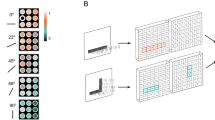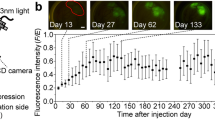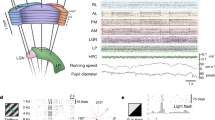Abstract
In noninvasive neuroimaging, neural activity is inferred from local fluctuations in deoxyhemoglobin. A fundamental question of functional magnetic resonance imaging (fMRI) is whether the inferred neural activity is driven primarily by synaptic or spiking activity. The answer is critical for the interpretation of the blood oxygen level–dependent (BOLD) signal in fMRI. Here, we have used well-established visual-system circuitry to create a stimulus that elicits synaptic activity without associated spike discharge. In colocalized recordings of neural and metabolic activity in cat primary visual cortex, we observed strong coupling between local field potentials (LFPs) and changes in tissue oxygen concentration in the absence of spikes. These results imply that the BOLD signal is more closely coupled to synaptic activity.
This is a preview of subscription content, access via your institution
Access options
Subscribe to this journal
Receive 12 print issues and online access
$209.00 per year
only $17.42 per issue
Buy this article
- Purchase on Springer Link
- Instant access to full article PDF
Prices may be subject to local taxes which are calculated during checkout




Similar content being viewed by others
References
Bandettini, P.A., Wong, E.C., Hinks, R.S., Tikofsky, R.S. & Hyde, J.S. Time course EPI of human brain function during task activation. Magn. Reson. Med. 25, 390–397 (1992).
Ogawa, S. et al. Intrinsic signal changes accompanying sensory stimulation: functional brain mapping with magnetic resonance imaging. Proc. Natl. Acad. Sci. USA 89, 5951–5955 (1992).
Kwong, K.K. et al. Dynamic magnetic resonance imaging of human brain activity during primary sensory stimulation. Proc. Natl. Acad. Sci. USA 89, 5675–5679 (1992).
Kim, S.G. & Ugurbil, K. Functional magnetic resonance imaging of the human brain. J. Neurosci. Methods 74, 229–243 (1997).
Logothetis, N.K. & Wandell, B.A. Interpreting the BOLD signal. Annu. Rev. Physiol. 66, 735–769 (2004).
Duong, T.Q., Kim, D.S., Ugurbil, K. & Kim, S.G. Localized cerebral blood flow response at submillimeter columnar resolution. Proc. Natl. Acad. Sci. USA 98, 10904–10909 (2001).
Kim, D.S. et al. Spatial relationship between neuronal activity and BOLD functional MRI. Neuroimage 21, 876–885 (2004).
Zheng, Y. et al. A model of the hemodynamic response and oxygen delivery to the brain. Neuroimage 16, 617–637 (2002).
Thompson, J.K., Peterson, M.R. & Freeman, R.D. Separate spatial scales determine neural activity–dependent changes in tissue oxygen within central visual pathways. J. Neurosci. 25, 9046–9058 (2005).
Offenhauser, N., Thomsen, K., Caesar, K. & Lauritzen, M. Activity-induced tissue oxygenation changes in rat cerebellar cortex: interplay of postsynaptic activation and blood flow. J. Physiol. (Lond.) 565, 279–294 (2005).
Thompson, J.K., Peterson, M.R. & Freeman, R.D. Single-neuron activity and tissue oxygenation in the cerebral cortex. Science 299, 1070–1072 (2003).
Fatt, I. Polarographic Oxygen Sensors 197–218 (CRC Press, Cleveland, Ohio, 1976).
Mathiesen, C., Caesar, K., Akgoren, N. & Lauritzen, M. Modification of activity-dependent increases of cerebral blood flow by excitatory synaptic activity and spikes in rat cerebellar cortex. J. Physiol. (Lond.) 512, 555–566 (1998).
Logothetis, N.K., Pauls, J., Augath, M., Trinath, T. & Oeltermann, A. Neurophysiological investigation of the basis of the fMRI signal. Nature 412, 150–157 (2001).
Caesar, K., Thomsen, K. & Lauritzen, M. Dissociation of spikes, synaptic activity, and activity-dependent increments in rat cerebellar blood flow by tonic synaptic inhibition. Proc Natl Acad Sci. USA 100, 16000–16005 (2003).
Devor, A. et al. Coupling of total hemoglobin concentration, oxygenation, and neural activity in rat somatosensory cortex. Neuron 39, 353–359 (2003).
Mukamel, R. et al. Coupling between neuronal firing, field potentials, and fMRI in human auditory cortex. Science 309, 951–954 (2005).
Niessing, J. et al. Hemodynamic signals correlate tightly with synchronized gamma oscillations. Science 309, 948–951 (2005).
Logothetis, N.K. The underpinnings of the BOLD functional magnetic resonance imaging signal. J. Neurosci. 23, 3963–3971 (2003).
Henrie, J.A. & Shapley, R. LFP power spectra in V1 cortex: the graded effect of stimulus contrast. J. Neurophysiol. 94, 479–490 (2005).
Malonek, D. & Grinvald, A. Interactions between electrical activity and cortical microcirculation revealed by imaging spectroscopy: implications for functional brain mapping. Science 272, 551–554 (1996).
Kreiman, G. et al. Object selectivity of local field potentials and spikes in the macaque inferior temporal cortex. Neuron 49, 433–445 (2006).
Liu, J. & Newsome, W.T. Local field potential in cortical area MT: stimulus tuning and behavioral correlations. J. Neurosci. 26, 7779–7790 (2006).
Rager, G. & Singer, W. The response of cat visual cortex to flicker stimuli of variable frequency. Eur. J. Neurosci. 10, 1856–1877 (1998).
Hawken, M.J., Shapley, R.M. & Grosof, D.H. Temporal-frequency selectivity in monkey visual cortex. Vis. Neurosci. 13, 477–492 (1996).
Gilbert, C.D. Laminar differences in receptive field properties of cells in cat primary visual cortex. J. Physiol. (Lond.) 268, 391–421 (1977).
Vanzetta, I. & Grinvald, A. Increased cortical oxidative metabolism due to sensory stimulation: implications for functional brain imaging. Science 286, 1555–1558 (1999).
Issa, N.P., Trepel, C. & Stryker, M.P. Spatial frequency maps in cat visual cortex. J. Neurosci. 20, 8504–8514 (2000).
Wilke, M., Logothetis, N.K. & Leopold, D.A. Local field potential reflects perceptual suppression in monkey visual cortex. Proc Natl Acad Sci. USA 103, 17507–17512 (2006).
von Stein, A., Chiang, C. & Konig, P. Top-down processing mediated by interareal synchronization. Proc Natl Acad Sci. USA 97, 14748–14753 (2000).
Jokisch, D. & Jensen, O. Modulation of gamma and alpha activity during a working memory task engaging the dorsal or ventral stream. J. Neurosci. 27, 3244–3251 (2007).
Maex, R. & Orban, G.A. Model circuit of spiking neurons generating directional selectivity in simple cells. J. Neurophysiol. 75, 1515–1545 (1996).
Acknowledgements
We thank Unisense A/S for continued collaboration in developing the combined sensor, J. Thompson for helpful comments during the conception of the project, P. Mitra and H. Bokil for assistance with LFP analysis, E. Allen and B. Pasley for helpful discussions, and B. Li for help with surgical preparation. This work was supported by research and CORE grants from the US National Eye Institute (EY01175 and EY03716) and a US National Science Foundation Graduate Research Fellowship (A.V.).
Author information
Authors and Affiliations
Contributions
A.V. conducted the experiments and data analysis. Both A.V. and R.D.F. discussed the results and wrote portions of the manuscript.
Corresponding author
Rights and permissions
About this article
Cite this article
Viswanathan, A., Freeman, R. Neurometabolic coupling in cerebral cortex reflects synaptic more than spiking activity. Nat Neurosci 10, 1308–1312 (2007). https://doi.org/10.1038/nn1977
Received:
Accepted:
Published:
Issue Date:
DOI: https://doi.org/10.1038/nn1977
This article is cited by
-
Invasive Recording of Local Field Potentials during Observation, Imagination, and Execution of Movements in Epilepsy Patients
Neuroscience and Behavioral Physiology (2022)
-
Intracellular ATP levels in mouse cortical excitatory neurons varies with sleep–wake states
Communications Biology (2020)
-
Rostral-Caudal Hippocampal Functional Convergence Is Reduced Across the Alzheimer’s Disease Spectrum
Molecular Neurobiology (2019)
-
Language function shows comparable cortical patterns by functional MRI and repetitive nTMS in healthy volunteers
Brain Imaging and Behavior (2019)
-
Layer-specificity in the effects of attention and working memory on activity in primary visual cortex
Nature Communications (2017)



